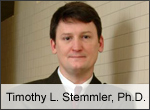
Science Magazine has published an article by Timothy L. Stemmler, Ph.D., associate professor of Biochemistry and Molecular Biology for the Wayne State University School of Medicine.
Dr. Stemmler's article, "A Cystosolic Iron Chaperone That Delivers Iron to Ferritin," was published May 30. The groundbreaking study centers around Dr. Stemmler's work with a human protein - PCBP1 - which binds iron and delivers it to an iron storage protein called ferritin within cells.
"There are a large number of cardio- and neurodegenerative disorders linked to an inability to properly regulate the availability and chemistry of metals that in normal patients are essential for life," explained Dr. Stemmler. "By understanding proteins that control metal homeostasis under normal conditions, we can provide basic biochemical insight into pathways that are deficient in patients that have these disorders. This insight can be used to design better treatment strategies for these patients."
Nearly all forms of life, Dr. Stemmler noted, require iron. However, each organism must balance the "advantageous aspects of the chemistry this metal can provide to a cell with the unfavorable oxidation chemistry this metal will perform if unregulated. To accomplish this, organisms generally store iron at the core of the multi-protein complex formed by ferritin. Ferritin will both accept iron when the metal is in high abundance and release metal when it is required in the cell."
The human protein, which Dr. Stemmler describes as an "iron chaperone," ensures the reactive iron is delivered to ferritin in a manner that prevents unwanted oxidation chemistry that could occur in the absence of the protein.
PCBP is a family of proteins that selectively deliver iron to ferritin.
This group is only the second known set of iron chaperones, and, Dr. Stemmler said, it is important in the capacity of iron storage throughout the body. Scientists have searched for the protein for decades. It was discovered in yeast by Dr. Caroling Philpott at the National Institutes of Health.
To read Dr. Stemmler's article in Science Magazine, visit http://www.sciencemag.org/cgi/content/full/320/5880/1207